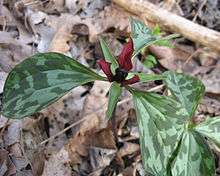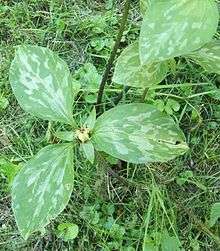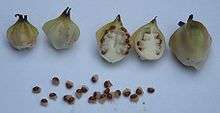Trillium recurvatum
| Trillium recurvatum | |
|---|---|
 | |
| Scientific classification | |
| Kingdom: | Plantae |
| (unranked): | Angiosperms |
| (unranked): | Monocots |
| Order: | Liliales |
| Family: | Melanthiaceae |
| Genus: | Trillium |
| Species: | T. recurvatum |
| Binomial name | |
| Trillium recurvatum L.C.Beck, 1826 | |
| Synonyms[2] | |
| |
Trillium recurvatum, the bloody butcher[3] or prairie trillium, is a member of the Melanthiaceae family. It occurs in parts of the central and eastern United States from Iowa south to Texas and east to North Carolina and Pennsylvania,[4] usually mesic deciduous forest, including tallgrass prairie savannah. Trees which frequently shade this trillium include oak, maple, ash and hickory.[5]


The blossom has three brown to maroon petals that are typically under 3 centimetres (1.2 in) long. The petals are recurved, with tips converging over the stamens.[6] The fruit has 6 well developed ridges (see photo). The seeds include structures known as elaiosomes, to promote dispersal by ants and other foraging insects.
Conservation status
Globally, the prairie trillium is considered to be secure (G5), but several states at the edge of its range have listed it. In Wisconsin, it is considered rare or uncommon (S3) and therefore a species of special concern.[7] In Michigan, it is considered a state threatened species and is protected by law (S2S3).[8]

| Wikimedia Commons has media related to Trillium recurvatum. |
References
- ↑ "Trillium recurvatum". NatureServe Explorer. NatureServe. Retrieved June 28, 2009.
- ↑ Kew World Checklist of Seelcted Plant Families
- ↑ "Trillium recurvatum". Natural Resources Conservation Service PLANTS Database. USDA. Retrieved 15 December 2015.
- ↑ Trillium recurvatum web page from Vanderbilt Bioimages
- ↑ Prairie Trillium, web page from Illinois Wildflowers
- ↑ Dan Tenaglia, Trillium Recurvatum web page from Missouri Plants
- ↑ Reflexed Trillium (Trillium revurvatum), Endangered Resources Program Species Information, Wisconsin Department of Natural Resources.
- ↑ Trillium Recurvatum, Michigan Natural Features Inventory, Lansing. (PDF)
